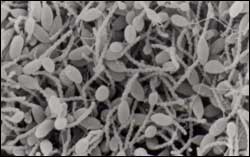Bacteria feed on smelly breath (and feet)

Hyphomicrobium sulfonivorans
Researchers have isolated bacteria which can grow on and ‘mop up’ smelly compounds in the mouth that are linked to bad breath. These smelly, highly reactive ‘one-carbon’ compounds are naturally produced from the breakdown of sulphur-containing amino acids in the mouth.
Dr Ann Wood and her colleagues at Kings College, London, reported these findings in the August issue of Environmental Microbiology. The odour-eating methylotrophic bacteria were isolated from the tongue, tooth plaques (supra-gingival plaques) and gum edge (sub-gingival plaques) of volunteers. They include strains of Bacillus, Brevibacterium casei, Hyphomicrobium sulfonivorans1, Methylobacterium, Micrococcus luteus and Variovorax paradoxus.
The composition and function of bacterial flora of the mouth have been extensively studied in the past, but until now it was not recognised that methylotrophic bacteria are part of the normal oral microbial environment or ‘microflora’.
The researchers found no difference between strains of bacteria found in the mouths of healthy volunteers and those suffering from progressive gum disease (periodontitis), a condition which is often associated with smelly breath. However, no assessment was made of the levels of methylotrophic bacteria present, low levels of which may be associated with bad breath.
In a previous paper, Dr Wood et al found that the foot is also a source of methylated sulphides and strains of these odour eating bacteria, including Brevibacterium and Methylobacterium, which are also part of the normal foot microbial flora.
The results of this study will assist future investigation into the detection of the levels of methylotrophic bacteria and their possible relationship with the oral concentrations of methylated sulphides. This may lead to a natural way of reducing smelly breath and feet.
Media Contact
More Information:
http://www.blackwell-synergy.com/toc/emi/7/8All latest news from the category: Life Sciences and Chemistry
Articles and reports from the Life Sciences and chemistry area deal with applied and basic research into modern biology, chemistry and human medicine.
Valuable information can be found on a range of life sciences fields including bacteriology, biochemistry, bionics, bioinformatics, biophysics, biotechnology, genetics, geobotany, human biology, marine biology, microbiology, molecular biology, cellular biology, zoology, bioinorganic chemistry, microchemistry and environmental chemistry.
Newest articles

Trotting robots reveal emergence of animal gait transitions
A four-legged robot trained with machine learning by EPFL researchers has learned to avoid falls by spontaneously switching between walking, trotting, and pronking – a milestone for roboticists as well…

Innovation promises to prevent power pole-top fires
Engineers in Australia have found a new way to make power-pole insulators resistant to fire and electrical sparking, promising to prevent dangerous pole-top fires and reduce blackouts. Pole-top fires pose…

Possible alternative to antibiotics produced by bacteria
Antibacterial substance from staphylococci discovered with new mechanism of action against natural competitors. Many bacteria produce substances to gain an advantage over competitors in their highly competitive natural environment. Researchers…





















